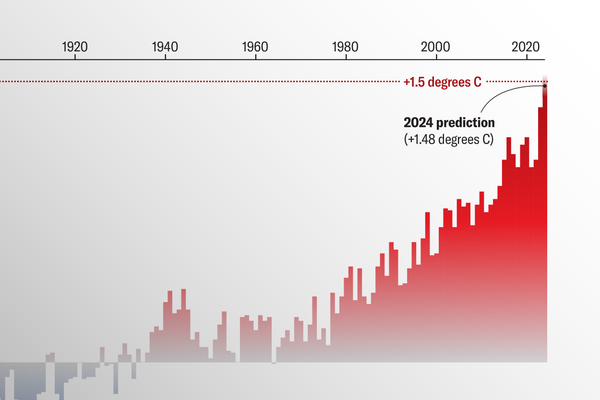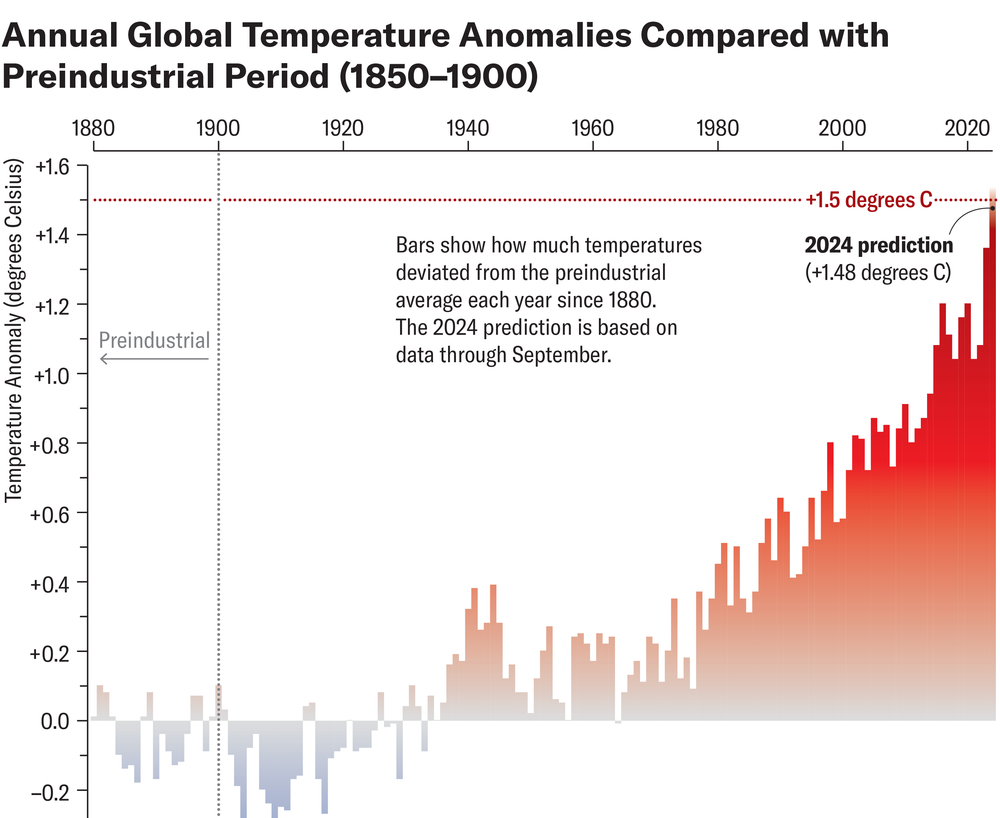October 30, 2024
4 min read
In Record-Hottest Year, U.S. Voters Will Decide Climate’s Path Forward
Global temperatures through September point to 2024 besting 2023 as the hottest year on record. How many future years set records depends in part on the outcome of the 2024 U.S. presidential election

Amanda Montañez; Source: Gavin A. Schmidt/NASA’s Goddard Institute for Space Studies (data)
As the U.S. stands on the precipice of one of the most consequential elections for climate change in history, one of NASA’s top climate scientists warns that “2024 is almost certain” to be the hottest year on record. If so, it will topple the remarkable record set just last year, driving home the path humanity has set itself on.
The consequences of our choice to continue burning fossil fuels that release heat-trapping greenhouse gases into the atmosphere go beyond those temperature records. They are increasingly clear in the devastating heat waves, hurricanes and other extreme weather events that have cost hundreds of lives and billions of dollars just in the U.S. this year. They are experienced in more subtle changes to the climate that affect crop yields and food prices and result in worsening health for millions.
Thousands of climate science studies have made it clear those effects will only get worse for future generations unless we begin to rapidly and dramatically reduce our emissions. The upcoming presidential election will be a pivotal point for the U.S. It will determine whether the country will continue with the significant climate action set in motion by the Biden-Harris administration, which could lead to large reductions in emissions—or whether it will, with the potential reelection of former president Donald Trump, encourage unfettered fossil fuel production and place few to no guardrails on emissions.
On supporting science journalism
If you’re enjoying this article, consider supporting our award-winning journalism by subscribing. By purchasing a subscription you are helping to ensure the future of impactful stories about the discoveries and ideas shaping our world today.
According to global temperature data collected through the end of September, 2024 is likely to be very close to 1.5 degrees Celsius (2.7 degrees Fahrenheit) warmer than the average global temperature from 1850 to 1900. That time range, often called the preindustrial period, marks a point before greenhouse gases started to significantly accumulate in the atmosphere from the burning of coal, oil and other fossil fuels. Under the 2015 Paris climate accord, countries agreed to try to limit warming to under that 1.5-degree-C threshold—and “well under” two degrees C (3.6 degrees F).

Amanda Montañez; Source: Gavin A. Schmidt/NASA’s Goddard Institute for Space Studies (data)
By NASA’s reckoning, 2023 was 1.36 degrees C (2.45 degrees F) hotter than the preindustrial period, and it took the title of hottest year by a record margin. Based on temperatures for 2024 through the end of September and a statistical model, NASA’s Goddard Institute of Space Studies director Gavin A. Schmidt calculated that the global average surface temperature for all of 2024 will be around 1.5 degrees C above preindustrial levels, give or take a couple hundredths of a degree C. That may not sound like much of an increase, but annual temperature records are typically set by hundredths of a degree, and it takes a tremendous amount of heat to raise global temperatures by that much.
The U.K. Met Office had previously predicted that the planet would have at least one year above the 1.5-degree-C mark between 2023 and 2027. One year does not mean the Paris accord goal has been breached—that goal is considered to apply to an average of multiple years—but it does show how close the world is to blowing past it.
Climate scientists say that almost all of last year’s and this year’s temperature records are the result of ever rising levels of greenhouse gases such as carbon dioxide. The World Meteorological Organization (WMO) just confirmed that CO2 reached a record high of 420 parts per million in 2023. “These are more than just statistics. Every part per million and every fraction of a degree temperature increase has a real impact on our lives and our planet,” said WMO Secretary-General Celeste Saulo in a recent statement.
Last year an El Niño event—which occurs when the tropical Pacific Ocean becomes hotter than normal, with cascading effects on global weather—provided a small boost to global temperatures, as it always does. Because the effect of this cyclical natural climate phenomenon tends to lag the event by a few months, it also slightly boosted temperatures this year.
In a series of posts on the social media site Bluesky, Schmidt noted that when his predecessor, James Hansen, testified before Congress about the dangers of climate change in 1988 (when carbon dioxide concentrations were 351 parts per million), that year was the hottest on record. The evidence “represents a very strong case, in my opinion, that the greenhouse effect has been detected, and it is changing our climate now,” Hansen said in his testimony.
Now 1988 ranks as the 31st hottest year.
Every single year of the 21st century has been hotter than 1988 was. In fact, every decade since then has been hotter than the previous one. Any record set this year will undoubtedly be broken before too long.
But the body of climate science research that has so long underscored the threat we face also makes clear that we are not doomed to perpetually hotter and hotter years—we have a choice in what the future climate looks like. As Texas A&M University climate scientist Andrew Dessler wrote recently on his blog, we know that if we stop emitting greenhouse gases, Earth will stop warming. And, he added, we essentially have the technology, particularly in the form of renewable energy and battery storage, to forgo fossil fuels. The main hurdle is political. That means that the votes we will cast in elections—and particularly this election—will be among the key choices we will make for that future.

